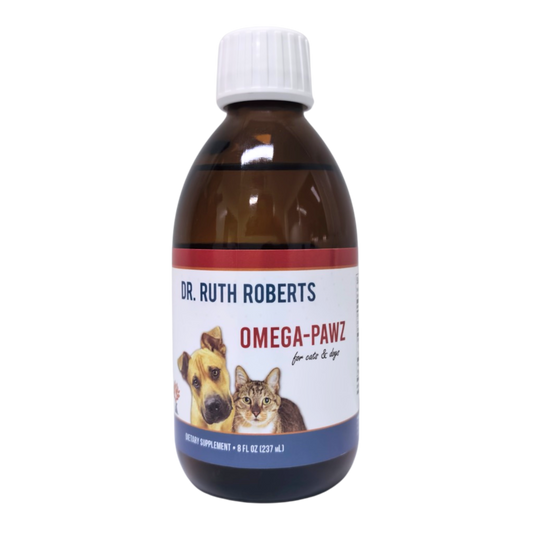-


Holistic Total Body Support – Multivitamin & Glandular Support for Dogs and Cats
Holistic Total Body Support – Multivitamin & Glandular Support for Dogs and Cats
Vendor:Dr. Ruth Roberts(42)Regular price $64.00 USDRegular priceUnit price per$64.00 USDSale price $64.00 USDHolistic Total Body Support formulated by Dr. Ruth Roberts is a daily multivitamin for dogs and cats, designed to complement a variety of feeding routines—including home-cooked diet. This powdered blend provides a wide range of essential vitamins, minerals, amino acids, and organ-based ingredients (known as glandular supplement), including calcium citrate for dogs and cats as part of its balanced formula. This versatile multivitamin is often selected by pet parents seeking a nutritional found...
-


The Original Crockpet Diet™ Ebook and Recipes
The Original Crockpet Diet™ Ebook and Recipes
Vendor:Dr. Ruth's Courses(42)Regular price $49.00 USDRegular priceUnit price per$97.00 USDSale price $49.00 USDIgnite the Chef in You for a Healthier, Happier Pet Are you tired of commercial pet food options that leave you guessing about what's really in your fur baby's bowl? Take control of your pet's nutrition with our comprehensive self-paced course! What You'll Learn🌟 TOCPD Cooking Essentials: Master the art of crafting balanced, nutritious homemade meals for your pets. Discover rotation diet templates tailored for both cats and dogs, ensuring a well-rounded diet. 🐶 TOCPD For Dogs: From succulent...
Sale -


Omega Pawz - Liquid Omega 3 Oil for Dogs and Cats
Omega Pawz - Liquid Omega 3 Oil for Dogs and Cats
Vendor:Dr. Ruth Roberts(42)Regular price $39.00 USDRegular priceUnit price perOmega Pawz by Dr. Ruth Roberts is a liquid omega 3 oil for dogs and cats, thoughtfully made with quality fish oil to complement your pet’s daily feeding routine. This easy-to-use formula includes EPA and DHA, two well-known omega-3 fatty acids found in marine sources. Whether you're looking for omega 3 oil for dogs to include as part of a regular rotation or exploring omega 3 oil for cats for variety in their diet, Omega Pawz offers a simple, pet-friendly option. The light lemon flavor helps ...
-


Canine Dermal Support, 1.1 oz (30 g)
Canine Dermal Support, 1.1 oz (30 g)
Vendor:Standard Process Inc(42)Regular price $20.35 USDRegular priceUnit price perCanine Dermal Support is a dog skin health supplement containing whole food-based ingredients to support your patients’ general skin health. This powder supplement contains whole food ingredients to help: Maintain proper liver, adrenal, immune, and intestinal function Support and maintain the skin's ability to withstand the effects of environmental exposure Nutrition plays a major role in skin health. Healthy skin is a result of a well-functioning, synchronized effort by tissues and org...
-


Canine Dermal Support, 4.4 oz (125 g)
Canine Dermal Support, 4.4 oz (125 g)
Vendor:Standard Process Inc(42)Regular price $69.85 USDRegular priceUnit price perCanine Dermal Support is a dog skin health supplement containing whole food-based ingredients to support your patients’ general skin health. This powder supplement contains whole food ingredients to help: Maintain proper liver, adrenal, immune, and intestinal function Support and maintain the skin's ability to withstand the effects of environmental exposure Nutrition plays a major role in skin health. Healthy skin is a result of a well-functioning, synchronized effort by tissues and org...
-


Pet's Daily Wellness Formula - For Pets With Pork/Beef Allergy
Pet's Daily Wellness Formula - For Pets With Pork/Beef Allergy
Vendor:Dr. Ruth Roberts(42)Regular price $54.00 USDRegular priceUnit price per$128.00 USDSale price $54.00 USDPet’s Daily Wellness Formula formulated by Dr. Ruth Roberts is a thoughtfully crafted multivitamin for dogs and cats, designed as a convenient daily addition to your pet’s feeding routine. This formula contains a full spectrum of vitamins, minerals, amino acids, and naturally sourced ingredients—including calcium citrate for dogs—to help fill common nutritional gaps. It’s especially well-suited for pets with dietary sensitivities, as it’s free of glandular ingredients like beef or pork organs...
Sale -


Tremella Mushroom Powder for Pets
Tremella Mushroom Powder for Pets
Vendor:Real Mushrooms(42)Regular price $34.95 USDRegular priceUnit price perReal Mushrooms Organic Tremella Mushroom Powder for Pets is a premium supplement crafted from USDA Certified Organic Tremella fuciformis mushrooms. Renowned for their natural hydrating properties, Tremella mushrooms are rich in Beta-glucans and antioxidants that may support balanced skin health and contribute to a shiny, healthy coat. This gentle, easy-to-use powder is designed for daily use in dogs and cats of all ages. It mixes effortlessly into meals, making it a convenient addition to...
-


5 Defenders Mushroom Blend Powder - Immune Support
5 Defenders Mushroom Blend Powder - Immune Support
Vendor:Real Mushrooms(42)Regular price $36.70 USDRegular priceUnit price perThis organic blend of mushrooms may help support immune function and vitality in pets. Made with carefully selected mushrooms known for their beneficial properties, it’s an easy way to complement your pet’s daily care routine. Key Features: Immune Support: Contains mushrooms like Reishi and Shiitake, which include natural compounds that may help support a balanced immune system. Rich in Antioxidants: Offers antioxidant properties that may help reduce oxidative stress. Clean and Natural Formu...
LET'S LEARN MORE ABOUT
Flea and Tick in Pets
Common Causes and Risk Factors
Common Symptoms of Tick and Flea Infestations
Prevention and Management Options
Talk to Us
If you need help with starting up the course or getting access to the recipes and videos, please don't hesitate to contact us via call/text at +213 394 2923 / email drruthroberts@drruthroberts.com.



















